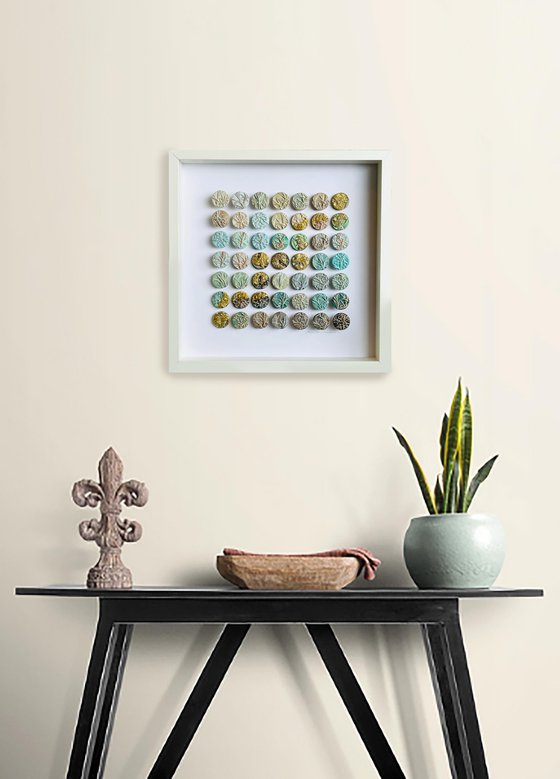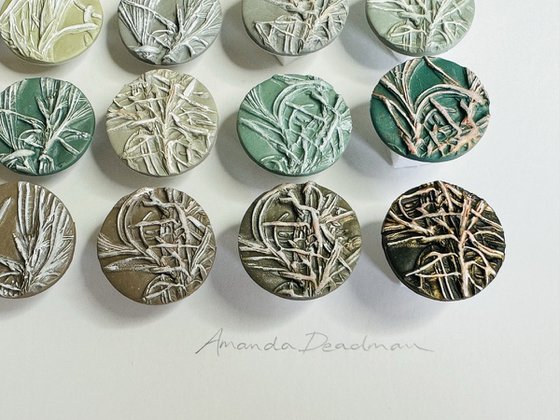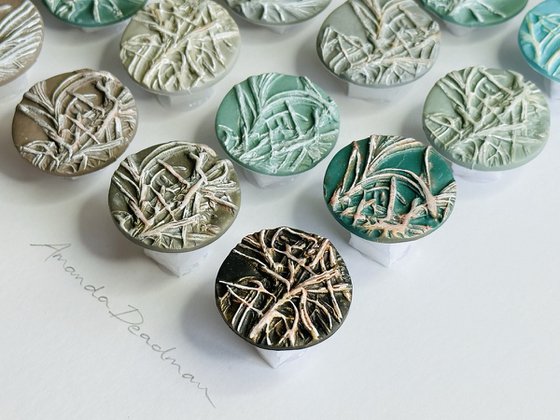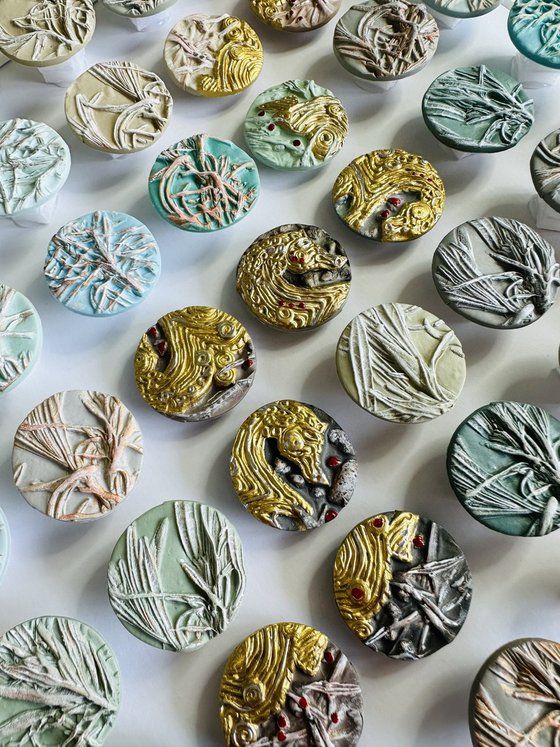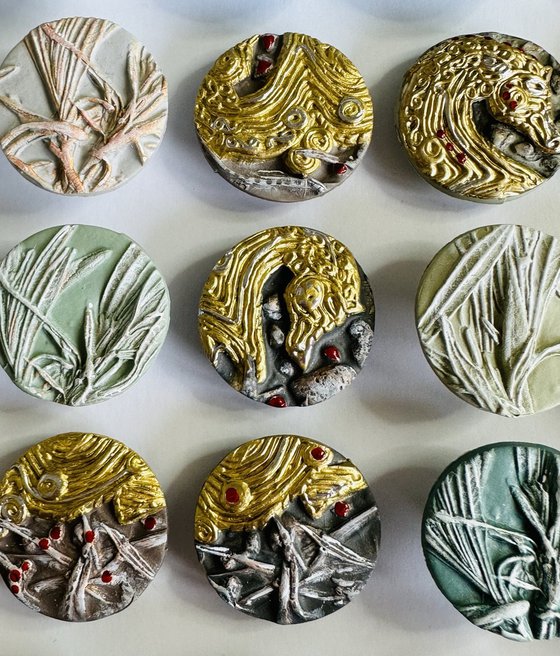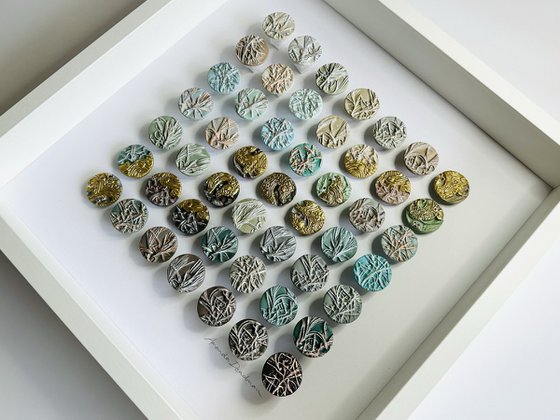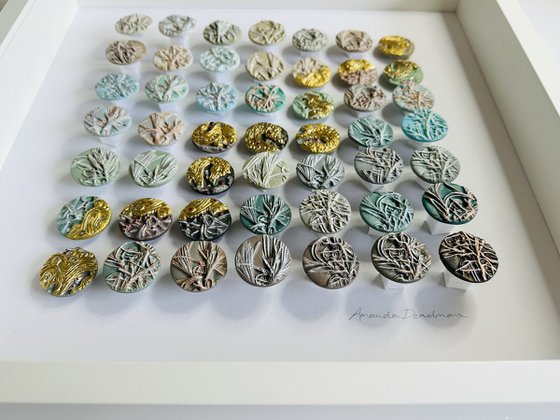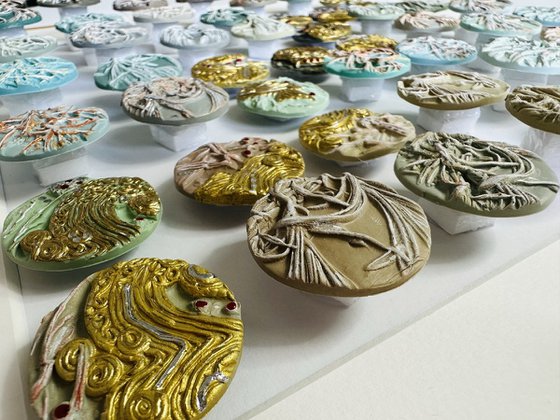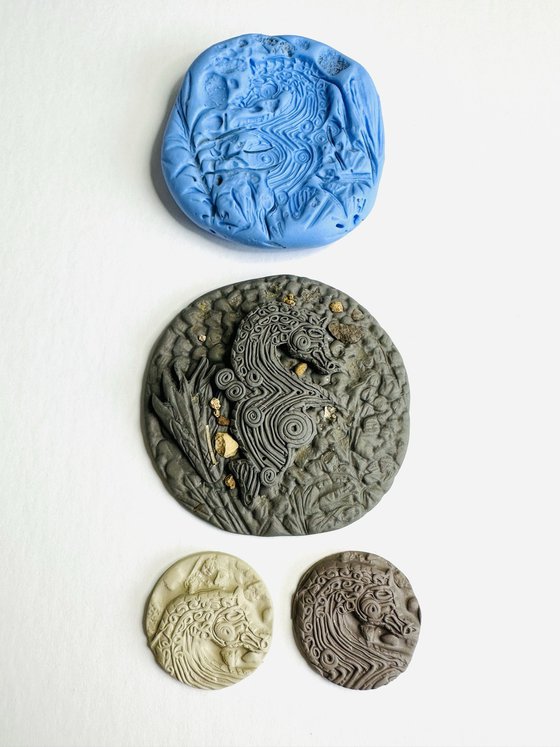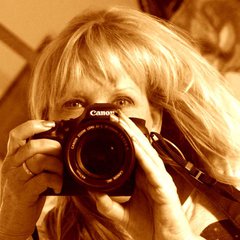Main Navigation
Original artwork description:
The inspiration for this piece was a visit to view "The Staffordshire Hoard", (the largest Anglo-Saxon treasure ever found), which at the time was on display at Sutton Hoo, in Suffolk, UK.
*In the forward of the British Museum book that accompanies the exhibition Leslie Webster writes:
"On 5th July 2009, a metal-detector user started to unearth gold objects in a staffordshire field. Thus began the discovery of the largest hoard of Anglo-Saxon treasure ever found. Consisting of over 1600 items - including fittings from the hilts of swords, fragments from helmets, Christian crosses and magnificent pieces of garnet work".
*"Fred Johnson had ploughed his field many times before, but October 2008 was different. Passing over the top of a hillock his plough swept under a long buried treasure, lifting and spreading it through the soil. There it rested until the following July, when Terry Herbert came to the field with his metal detector. As Terry walked over the spot where Fred's plough had disturbed the hoard, his detector gave a signal. He picked up a piece of glittering metal; he thought that it was an old keyhole fitting but, looking closely, he realised that it was gold. Then he found another piece, and another: the earth seemed full of gold and silver".
Looking at the artifacts and reading the account of their discovery I had a tingling sense of what it must have felt like at the time of their unearthing.
So for this piece I created a tiny sculpture in polymer clay that I could then take a mould of. The sculpture was inspired by one of the unidentified gold filigree objects that looks like a seahorse! I already had moulds of foliage from my first Unearthing artwork so for this piece I combined the two sets of moulds to create the discs that make up this second artwork.
Unlike my first Unearthing artwork all of the larger sized discs are mounted on different height tiny foam-board plinths; higher at the sides and lowering down to the metallic discs emerging from the undergrowth through its centre!
The moulded multi-coloured polymer clay discs are highlighted with white, gold and bronze acrylic, and the central discs are picked out with gold and silver high gloss liquid chromium, and polymer clay gloss glaze mixed with red alcohol inks.
The whole piece is framed in a deep white box frame which is glazed with Perspex.
* Leslie Webster is a retired British Museum curator and art historian.
* The British Museum exhibition book (ISBN 978-0-7141-2342-4) is written by Kevin Leahy, National Finds Advisor, and Roger Bland, Keeper of the Department of Portable Antiquities of Prehistory and Europe at the British Museum.
Materials used:
Moulded coloured polymer clay on foam board on card in a box frame glazed with Perspex
Tags:
#art for #3d relief #moulded polymer #the staffordshire #unearthing treasure #metal detector #treasure hunter #gold treasureUnearthing II (2023) Relief
by Amanda Deadman
30 Artist Reviews
£395 Sold
- Relief on Paper on board
- One of a kind artwork
- Size: 37 x 37 x 6cm (framed) / 33.5 x 33.5cm (actual image size)
- Framed and ready to hang
- Signed on the front
- Style: Organic
- Subject: Abstract and non-figurative
Do you like this artwork?
This artwork has sold, but the artist is accepting commission requests. Commissioning an artwork is easy and you get a perfectly personalised piece.
Loading
Original artwork description
The inspiration for this piece was a visit to view "The Staffordshire Hoard", (the largest Anglo-Saxon treasure ever found), which at the time was on display at Sutton Hoo, in Suffolk, UK.
*In the forward of the British Museum book that accompanies the exhibition Leslie Webster writes:
"On 5th July 2009, a metal-detector user started to unearth gold objects in a staffordshire field. Thus began the discovery of the largest hoard of Anglo-Saxon treasure ever found. Consisting of over 1600 items - including fittings from the hilts of swords, fragments from helmets, Christian crosses and magnificent pieces of garnet work".
*"Fred Johnson had ploughed his field many times before, but October 2008 was different. Passing over the top of a hillock his plough swept under a long buried treasure, lifting and spreading it through the soil. There it rested until the following July, when Terry Herbert came to the field with his metal detector. As Terry walked over the spot where Fred's plough had disturbed the hoard, his detector gave a signal. He picked up a piece of glittering metal; he thought that it was an old keyhole fitting but, looking closely, he realised that it was gold. Then he found another piece, and another: the earth seemed full of gold and silver".
Looking at the artifacts and reading the account of their discovery I had a tingling sense of what it must have felt like at the time of their unearthing.
So for this piece I created a tiny sculpture in polymer clay that I could then take a mould of. The sculpture was inspired by one of the unidentified gold filigree objects that looks like a seahorse! I already had moulds of foliage from my first Unearthing artwork so for this piece I combined the two sets of moulds to create the discs that make up this second artwork.
Unlike my first Unearthing artwork all of the larger sized discs are mounted on different height tiny foam-board plinths; higher at the sides and lowering down to the metallic discs emerging from the undergrowth through its centre!
The moulded multi-coloured polymer clay discs are highlighted with white, gold and bronze acrylic, and the central discs are picked out with gold and silver high gloss liquid chromium, and polymer clay gloss glaze mixed with red alcohol inks.
The whole piece is framed in a deep white box frame which is glazed with Perspex.
* Leslie Webster is a retired British Museum curator and art historian.
* The British Museum exhibition book (ISBN 978-0-7141-2342-4) is written by Kevin Leahy, National Finds Advisor, and Roger Bland, Keeper of the Department of Portable Antiquities of Prehistory and Europe at the British Museum.
Materials used:
Moulded coloured polymer clay on foam board on card in a box frame glazed with Perspex
Tags:
#art for #3d relief #moulded polymer #the staffordshire #unearthing treasure #metal detector #treasure hunter #gold treasure14 day money back guaranteeLearn more



